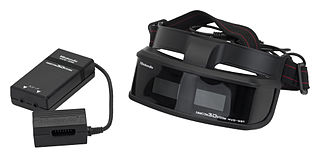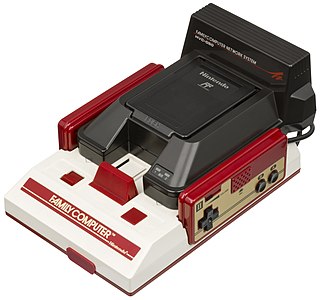 W
WThe 64DD is a magnetic floppy disk drive peripheral for the Nintendo 64 game console developed by Nintendo. It was announced in 1995, prior to the Nintendo 64's 1996 launch, and after numerous delays was released in Japan on December 13, 1999. The "64" references both the Nintendo 64 console and the 64MB storage capacity of the disks, and "DD" is short for "disk drive" or "dynamic drive".
 W
WThe Casio Loopy , subtitled My Seal Computer SV-100, is a 32-bit home video game console. Released exclusively in Japan in October 1995, it was unique in that the marketing for it was completely targeted to female gamers.
 W
WThe Color TV-Game is the first video game system ever made by Nintendo. The system was released as a series of five dedicated home video game consoles between 1977 and 1980 in Japan only. Nintendo sold three million units of the first four models: one million units of each of the first two models, Color TV-Game 6 and 15; and half a million units of each of the next two models, Block Breaker and Racing 112. The Color TV-Game series has the highest sales figures of all the first generation of video game consoles.
 W
WThe Famicom 3D System is a Japan-exclusive accessory for the Nintendo Family Computer released in 1987.
 W
WFamicom Data Recorder (HVC-008) is a compact cassette tape data interface introduced in 1984, for the Famicom which had been introduced in 1983. It is compatible with four Famicom games, for saving user-generated content to tapes. As Nintendo's first rewritable storage medium, it was replaced by the Famicom Disk System in 1986.
 W
WThe Family Computer Disk System, commonly shortened to the Famicom Disk System or just Disk System, is a peripheral for Nintendo's Family Computer home video game console, released only in Japan on February 21, 1986. It uses proprietary floppy disks called "Disk Cards" for cheaper data storage and it adds a new high-fidelity sound channel for supporting Disk System games.
 W
WThe Famicom Titler (ファミコンタイトラー), also known as the Famicom Editor , is a Nintendo-licensed Famicom-compatible home video game console produced by Sharp Corporation in 1989. The console was released exclusively in Japan at a retail price of ¥43,000. Intended for capturing footage of Famicom games, the system is noted for its crisp image clarity due to its internally-generated RGB signal and usage of S-Video for output.
 W
WThe Family Computer Network System , also known as the Famicom Net System and Famicom Modem, is a peripheral for Nintendo's Family Computer video game console, and was released in September 1988 only in Japan. Predating the modern Internet, its proprietary dial-up information service accessed live stock trades, video game cheats, jokes, weather forecasts, betting on horse racing, and a small amount of downloadable content. The device uses a ROM card storage format, reminiscent to the HuCard for the TurboGrafx-16 and the Sega Card for the Master System.
 W
WThe FM Towns Marty is a fifth-generation home video game console released in 1993 by Fujitsu, exclusively for the Japanese market. It is often claimed to be the first 32-bit CD-based home video game system, although it has a 16-bit data bus, just like the earlier Commodore CDTV and Sega CD, which both have Motorola 68000 processors that are similar internally 16/32-bit, but with a 16-bit data bus. The console came complete with a built in CD-ROM drive and disk drive. It was based on the earlier FM Towns computer system Fujitsu had released in 1989. The Marty was backward-compatible with older FM Towns games.
 W
WThe Neo Geo Pocket is a monochrome handheld game console released by SNK. It was the company's first handheld system and is part of the Neo Geo family. It debuted in Japan in late 1998 but never saw an American release, being exclusive to Japan, Asia and Europe.
 W
WThe Nintendo Power is a Japan-only peripheral produced by Nintendo for the Super Famicom and the Game Boy. The service allowed owners to download Super Famicom or Game Boy games onto a special flash memory cartridge for a lower price than that of the full cartridge.
 W
WThe PC-FX is a 32-bit home video game console developed by NEC and Hudson Soft. It was released in 1994 and discontinued in February 1998, as NEC's final home video game console. Based on the NEC V810 CPU and CD-ROM, it was intended as the successor to the TurboGrafx-16. Unlike its predecessor, the PC-FX was only released in Japan.
 W
WThe Playdia is a fifth-generation home video game console released exclusively in Japan in 1994 at the initial price of ¥24,800. It was intended for a young audience and, like many consoles of the era, was marketed more as a multimedia home entertainment system than as a dedicated gaming console, with anime quiz software and edutainment making up most of the game library. The Playdia uses a single infrared joypad with simple controls. Bandai, the Playdia's manufacturer, was the only software publisher to support this console.
 W
WThe PocketStation is a Memory Card peripheral by Sony Computer Entertainment for the PlayStation home video game console. Categorized by Sony as a combination of a Memory Card and a miniature personal digital assistant, the device features a monochrome liquid crystal display (LCD), infrared communication capability, a real-time clock, built-in flash memory, and sound capability. To use the device's memory card functionality, it must be connected to a PlayStation through a memory card slot. It was released exclusively in Japan on January 23, 1999.
 W
WThe PSX is a Sony digital video recorder with a fully integrated PlayStation 2 home video game console. It was released in Japan on December 13, 2003. Since it was designed to be a general-purpose consumer video device, it was marketed by the main Sony Corporation instead of Sony Computer Entertainment and does not carry the usual PlayStation branding. Its high cost resulted in poor sales, prompting Sony to cancel plans to release the PSX outside Japan, making it a commercial failure.
 W
WThe Satellaview is a satellite modem peripheral produced by Nintendo for the Super Famicom in 1995. Containing 1 megabit of ROM space and an additional 512 kB of RAM, Satellaview allowed players to download games, magazines, and other media through satellite broadcasts provided by Japanese company St.GIGA. Its heavy third-party support included Squaresoft, Taito, Konami, Capcom, and Seta. To use Satellaview, players purchased a special broadcast satellite (BS) tuner directly from St.GIGA or rented one for a six-month fee, and paid monthly subscription fees to both St.GIGA and Nintendo. It attaches to the expansion port on the bottom of the Super Famicom.
 W
WThe TeraDrive is an IBM PC compatible system with an integrated Mega Drive, developed by Sega and manufactured by IBM in 1991. The TeraDrive allowed for Mega Drive games to be played the same time as the PC section is being used, as it is possible for the Mega Drive and PC hardware to interact with each other.
 W
WThe Super Famicom Naizou TV SF1 is a television set produced by Sharp Corporation with a built-in licensed Super Famicom. Released only to Japanese markets, the unit retailed in 1990 as a next generation successor to the 1983 C1 television also produced by Sharp and licensed by Nintendo. Like the C1, the SF1 was noted as having superior picture quality to a SFC plugged into a standard television.
 W
WThe Terebikko is an interactive VHS console game system released in Japan by Bandai in 1988. Titles released included a wide variety of known franchises, such as Super Mario World, Dragon Ball Z, and many more. The system was also released in the U.S. as the See 'n Say Video Phone by Mattel in 1989.
 W
Wtoio is an educational video game console developed by Sony Interactive Entertainment. It consists of two miniature robots, a docking station with a monochrome display, a cartridge port to load software onto, and two controllers. After shipping to crowdfunding backers in January 2018, the platform was released across Japan in March 2019.
 W
WThe Twin Famicom is a home video game console that was produced by Sharp Corporation in 1986 and was only released in Japan. It is a licensed Nintendo product that combines the Family Computer (Famicom) and the Family Computer Disk System (FDS) into a single piece of hardware. Sharp removed most Nintendo branding from the system, even going as far as to remove the "Nintendo" branding from the Famicom Disk System startup, replacing it with the same "FAMICOM" logo used on the system itself.
 W
WThe WonderSwan is a handheld game console released in Japan by Bandai. It was developed by Gunpei Yokoi's company Koto Laboratory and Bandai, and was the last piece of hardware Yokoi developed before his death in 1997. Released in 1999 in the fifth generation of video game consoles, the WonderSwan and its two later models, the WonderSwan Color and SwanCrystal were officially supported until being discontinued by Bandai in 2003. During its lifespan, no variation of the WonderSwan was released outside of Japan.